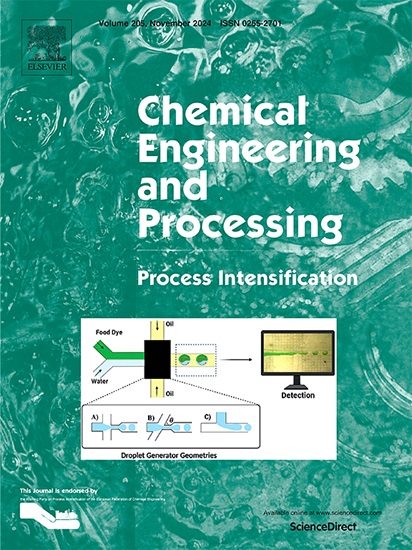Optimizing underwater plasma discharges: Role of electrode geometry and electrical design
IF 3.8
3区 工程技术
Q3 ENERGY & FUELS
Chemical Engineering and Processing - Process Intensification
Pub Date : 2025-06-13
DOI:10.1016/j.cep.2025.110409
引用次数: 0
Abstract
This study investigates the optimization of underwater plasma discharges by examining the influence of electrode geometry and electrical design on contaminant removal efficiency. A plasma-chemical reactor capable of igniting multiple discharges within a solution was developed, utilizing iron and molybdenum electrodes to explore the electrical characteristics and energy distribution among discharge channels. Experimental results revealed that increasing the number of electrodes enhances discharge frequency, with the two-discharge configuration exhibiting the highest energy efficiency for chemical processes, including radical generation and hydrogen peroxide formation. Notably, the majority of input energy was dissipated as Joule heating; however, the two-discharge system demonstrated a reduced thermal gradient, favoring chemical reactions over thermal losses. Testing with a model dye-contaminated solution showed optimal degradation efficiency for the two-discharge setup, attributed to the synergistic effects of reactive species generation and electrode-derived oxide structures. Molybdenum electrodes, despite yielding lower hydrogen peroxide concentrations, achieved significant dye removal due to their high sorption capacity. These findings underscore the importance of discharge topology in reactor design, suggesting that sequential discharge architectures represent a promising approach to maximize oxidative capacity while minimizing energy dissipation. This work provides critical insights for advancing plasma-based water treatment technologies.

优化水下等离子体放电:电极几何和电气设计的作用
本研究通过考察电极几何形状和电气设计对水中等离子体去除污染物效率的影响,探讨了水下等离子体放电的优化。开发了一种能够在溶液中点燃多次放电的等离子体化学反应器,利用铁和钼电极探索放电通道之间的电学特性和能量分布。实验结果表明,增加电极数量可以提高放电频率,双放电结构在化学过程中表现出最高的能量效率,包括自由基的产生和过氧化氢的形成。值得注意的是,大部分输入能量以焦耳加热的形式耗散;然而,双放电系统显示出降低的热梯度,有利于化学反应而不是热损失。在染料污染模型溶液中进行的测试表明,由于活性物质生成和电极衍生的氧化物结构的协同作用,双放电设置的降解效率最佳。钼电极尽管产生较低的过氧化氢浓度,但由于其高吸附能力,实现了显著的染料去除。这些发现强调了放电拓扑在反应器设计中的重要性,表明顺序放电结构代表了一种有前途的方法,可以最大化氧化能力,同时最小化能量消耗。这项工作为推进等离子体水处理技术提供了重要的见解。
本文章由计算机程序翻译,如有差异,请以英文原文为准。
求助全文
约1分钟内获得全文
求助全文
来源期刊
CiteScore
7.80
自引率
9.30%
发文量
408
审稿时长
49 days
期刊介绍:
Chemical Engineering and Processing: Process Intensification is intended for practicing researchers in industry and academia, working in the field of Process Engineering and related to the subject of Process Intensification.Articles published in the Journal demonstrate how novel discoveries, developments and theories in the field of Process Engineering and in particular Process Intensification may be used for analysis and design of innovative equipment and processing methods with substantially improved sustainability, efficiency and environmental performance.

 求助内容:
求助内容: 应助结果提醒方式:
应助结果提醒方式:


